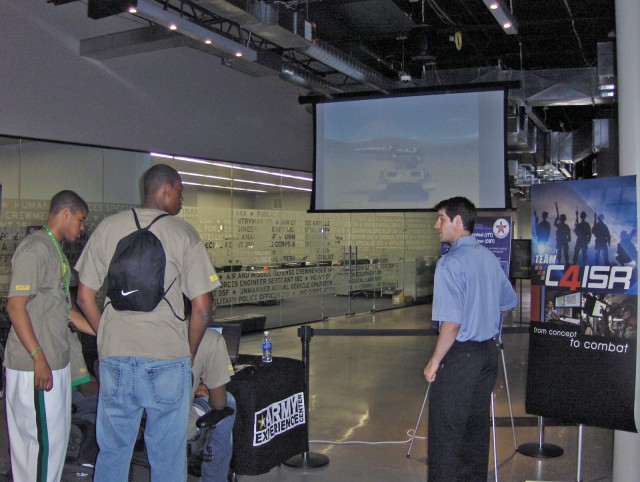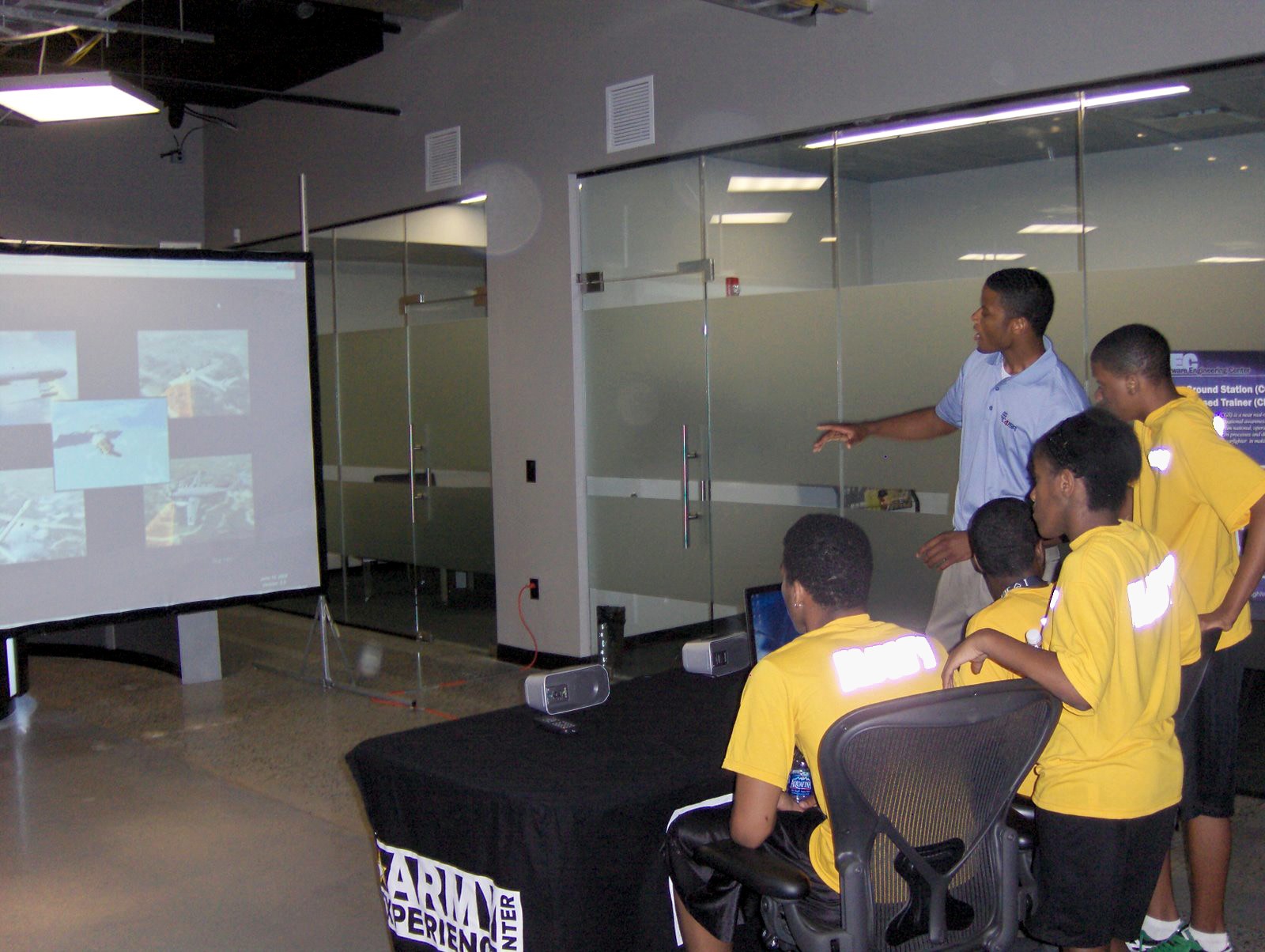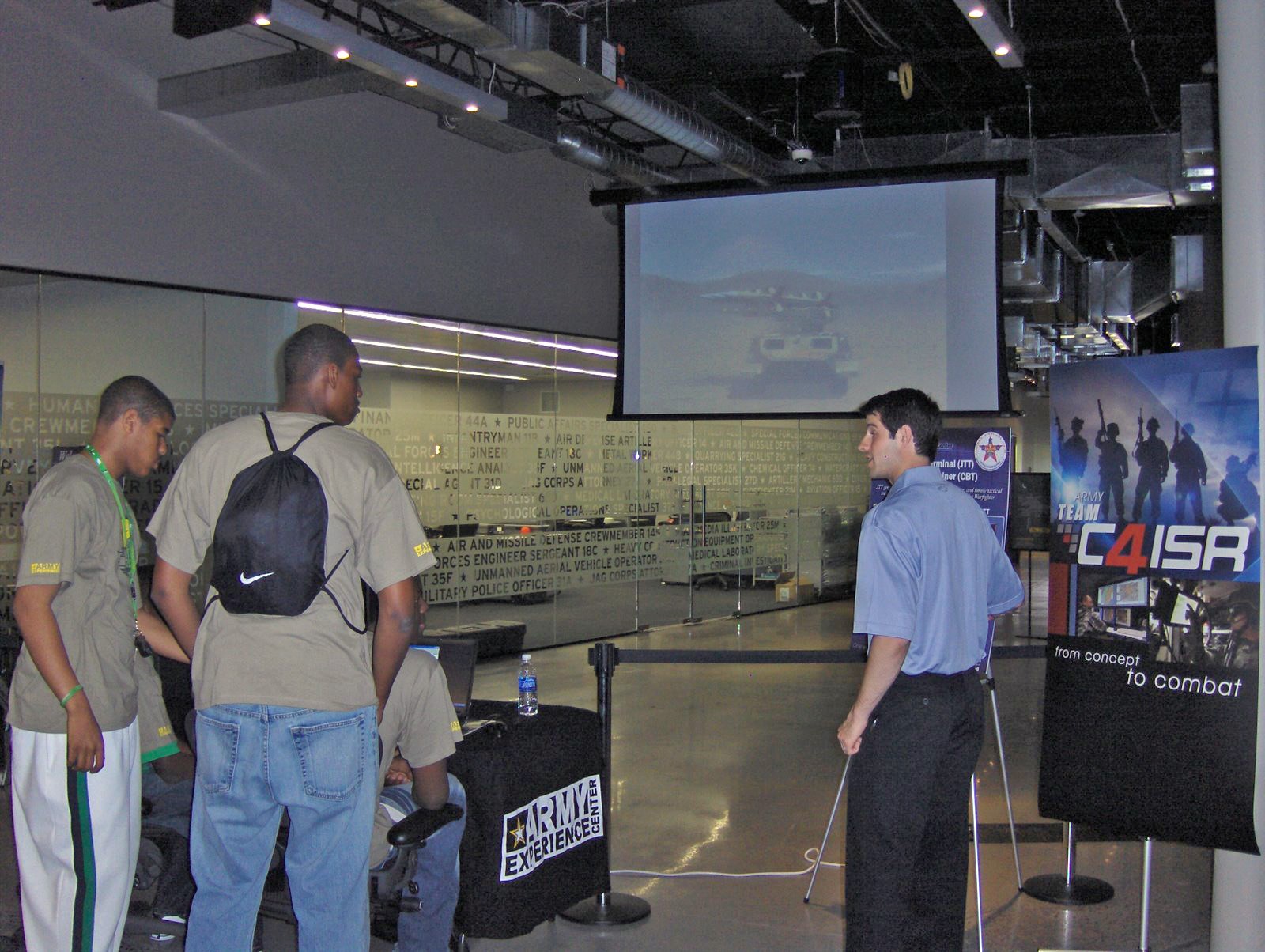Using computer-based trainers and video games, two U.S. Army interns from Fort Monmouth offered valuable insight into their work to 50 Junior Reserve Officer Training Corps students at the Army Experience Center in Philadelphia, May 8 and 9.
Jarad Wormley and Jason Rudolph hoped to enlighten the ninth through 12th-graders on what it means to be in the Army from a software engineer's perspective. Other military presenters, including the U.S. Army Drill Sergeant of the Year, Sgt. 1st Class Herbert D. Thompson IV, provided views from other sectors of the Army.
After being split into groups of four, the Navy JROTC students from Roxborough High School and Army JROTC students from Ben Franklin High School spent the two days visiting 10 hands-on display stations that demonstrated different areas of the Army.
While some stations were dedicated to physical endurance, requiring students to do push-ups, and others concentrated on math and geography tests, Rudolph and Wormley hosted the only stations that focused on technology.
During each of their 12, 10-minute presentations, Wormley and Rudolph spent an equal amount of time explaining the workings of each CBT and allowing the students to interact with the systems.
Both interns used CBTs, the software employed to prepare Soldiers for the different hardware configurations and software applications they will use in the field, to provide the students with an accurate Army experience.
"Kids can come in [to the AEC] and become acquainted with different types of Army equipment and various commercially available games; you know, just to get a feel for what it's like to be in the Army. So they wanted us there so that we could present our computer-based trainers and give them a more practical interpretation of what it means to actually be in the Army and undergo supplementary training," said Wormley.
As a software engineer for the Communications-Electronics Research, Development and Engineering Center's Software Engineering Directorate, Wormley demonstrated the user-friendly nature of CBTs and gave an informative presentation on the Common Ground Station. Through the CBT, CGS operators are able to follow wiring configurations, set up hardware and become accustomed to the CGS operating system. His presentation incorporated a virtual portrayal of an actual HMMWV, which houses the CGS.
"I told them about the various systems that the CGS is capable of communicating with. We have antennas that receive data such as signal intelligence and moving target indicators. I explained that to them and told them that CGS is a system that takes all of that information, processes it and disseminates it out into the field, to the Soldiers, to the commander," Wormley said. "We get that information to the commander so that he can make a decision on whether or not to fire or whether to stand down."
Rudolph, an information technology specialist for the Software Engineering Center, gave a presentation on Joint Tactical Terminal CBTs. His station included radios and interactive video games that gave students a comprehensive look at Army software engineering.
"After they saw the big picture that is the CGS, they saw one of the incorporated systems, which is the JTT. My system, which is a radio, provides signals intelligence data to Jarad's system," Rudolph said. "There are two radios in my project, and one of them is basically shipped in two suitcases and the package is sometimes airdropped into the field. The JTT CBT shows both radios, including everything that is in the suitcases and how to set it up from scratch. It also covers how to plug in all the hardware, install the software and start receiving data."
Rudolph's station also featured a computer game that tested students on what they learned during his presentation.
"If you didn't gain the knowledge, you won't be able to beat the game. Our target audience is really freshman to senior-level high schoolers that are getting ready to graduate and join the Army. So it was really great to find a good target audience to get some valuable feedback," Rudolph said.
Although the event featured an Apache helicopter and gave students the opportunity to play high-graphic Army video games, Rudolph and Wormley strongly believe that their demonstrations offered a unique and significant perspective, especially for the students with serious inclinations toward military service.
"That's not what everybody's going to see. Not everyone's going to do infantry, combat on the floor; not everyone's flying Apaches," Rudolph said.
"I mean, there were a lot of kids there that were realistically considering joining the Army, and they expressed uncertainty about what they were getting themselves into. Knowing that the Common Ground Station is out there to, in a sense, watch over them in the field and understanding that they're going to get some kind of formal and informal CBT training once they get into the Army, I think that was a lot more comforting to them and a lot more reassuring," Wormley said.
Rudolph and Wormley volunteered to go to the event after an Aberdeen Proving Ground employee, Nelson Gomez, sought representatives from SEC.
"They just wanted to get some recognition for the software-side of the Army, so that way the kids get more of a bird's eye view of everything the Army does," said Rudolph.
"I think they wanted [us] to bridge the gap, show them the difference between actual games and what it means to have a real computer-based trainer that people in the Army actually use," said Wormley.
The AEC is a 14,500-square-foot facility in Philadelphia's Franklin Mills Mall that uses interactive technologies and simulations along with online and in-person learning programs to inform its guests about opportunities in the U.S. Army.
The AEC is open to the public year round and staffed with enlisted Soldiers and retired veterans. Although the AEC does not recruit for the Army, Rudolph believes it is a significant tool to increase Army visibility and educate students.
"The more exposure, the better. The Army does a lot of advertising on TV, but it's just a commercial. Everyone that works in the AEC is an enlisted officer, so they can give you feedback on what boot camp is like and tell you what it's like to be deployed if some of them have," Rudolph said. "Also, they have things there like a salary calculator so you can input various aspects of your life, and it will compare your salary to what you would get same job as a civilian. They don't put pressure on you to sign up because they can't recruit you there, so it's just a place to get exposure and for the kids to get information."
Rudolph and Wormley both agreed that visits like theirs were important in the effort to educate adolescents about the Army, a fact that became especially apparent to them when hearing some of the students' reactions to their presentations.
"A lot of the students would say, 'Wow! I didn't know that the Army did so much. I just thought that the Army was running around shooting at people. I didn't realize that you guys had this much high-tech stuff.' A lot of the kids were amazed by that. At the end of the day, that meant a lot to me," Wormley said.




Social Sharing